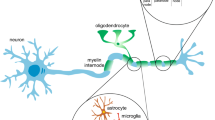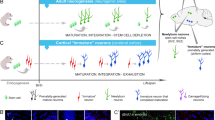Abstract
Neurogenesis in the adult dentate gyrus (DG) of the hippocampus allows the continuous generation of new neurons. This cellular process can be disturbed under specific environmental conditions, such as epileptic seizures; however, the underlying mechanisms responsible for their control remain largely unknown. Although different studies have linked the JNK (c-Jun-N-terminal-kinase) activity with the regulation of cell proliferation and differentiation, the specific function of JNK in controlling adult hippocampal neurogenesis is not well known. The purpose of this study was to analyze the role of JNK isoforms (JNK1/JNK2/JNK3) in adult-hippocampal neurogenesis. To achieve this goal, we used JNK-knockout mice (Jnk1−/−, Jnk2−/−, and Jnk3−/−), untreated and treated with intraperitoneal injections of kainic acid (KA), as an experimental model of epilepsy. In each condition, we identified cell subpopulations at different stages of neuronal maturation by immunohistochemical specific markers. In physiological conditions, we evidenced that JNK1 and JNK3 control the levels of one subtype of early progenitor cells (GFAP+/Sox2+) but not the GFAP+/Nestin+ cell subtype. Moreover, the absence of JNK1 induces an increase of immature neurons (Doublecortin+; PSA-NCAM+ cells) compared with wild-type (WT). On the other hand, Jnk1−/− and Jnk3−/− mice showed an increased capacity to maintain hippocampal homeostasis, since calbindin immunoreactivity is higher than in WT. An important fact is that, after KA injection, Jnk1−/− and Jnk3−/− mice show no increase in the different neurogenic cell subpopulation analyzed, in contrast to what occurs in WT and Jnk2−/− mice. All these data support that JNK isoforms are involved in the adult neurogenesis control.






Similar content being viewed by others
Abbreviations
- ABC:
-
avidin-biotin-peroxidase complex
- CB:
-
calbindin
- CR:
-
calretinin
- CT:
-
control
- CBP:
-
Calcium-binding protein
- DAB:
-
diaminobenzidine
- DCX:
-
doublecortin
- DG:
-
dentate gyrus
- FBS:
-
fetal bovine serum
- GCL:
-
granular cell layer
- GC:
-
granule cells
- GFAP:
-
glial fibrillary acidic protein
- i.p:
-
intraperitoneal injection
- IR:
-
immunoreactive
- JNKs:
-
c-Jun N-terminal kinases
- JNK1, JNK2, and JNK3:
-
JNK isoforms
- jnk1 :
-
Knockout mice for JNK1
- jnk2 −/− :
-
knockout mice for JNK2
- jnk3 :
-
knockout mice for JNK3
- KA:
-
kainic acid
- KO:
-
knockout
- NSC:
-
neural stem cells
- O/N:
-
overnight
- PB:
-
phosphate buffer
- PBS:
-
phosphate-buffered saline
- PSA-NCAM:
-
polysialic acid neural cell adhesion molecule
- RT:
-
room temperature
- SD:
-
standard deviation
- SDA-PAGE:
-
sodium dodecyl sulfate polyacrylamide gel electrophoresis.
- SDS:
-
sodium dodecyl sulfate
- SEM:
-
standard error of mean
- SGZ:
-
subgranular zone
- TLE:
-
temporal lobe epilepsy
- WT:
-
wild type
References
Davis RJ (2000) Signal transduction by the JNK group of MAP kinases. Cell 103:239–252
Gupta S, Barrett T, Whitmarsh a J et al (1996) Selective interaction of JNK protein kinase isoforms with transcription factors. EMBO J 15:2760–2770
Ip YT, Davis RJ (1998) Signal transduction by the c-Jun N-terminal kinase (JNK)--from inflammation to development. Curr Opin Cell Biol 10:205–219
Karin M (1995) The regulation of AP-1 activity by mitogen-activated protein kinases. J Biol Chem 270:16483–16486. https://doi.org/10.1098/rstb.1996.0008
Bogoyevitch MA, Kobe B (2006) Uses for JNK: the many and varied substrates of the c-Jun N-terminal kinases. Microbiol Mol Biol Rev 70:1061–1095. https://doi.org/10.1128/MMBR.00025-06
Gkouveris I, Nikitakis NG (2017) Role of JNK signaling in oral cancer: a mini review. Tumor Biol 39:101042831771165
Dong C, Yang DD, Wysk M, Whitmarsh AJ, Davis RJ, Flavell RA (1998) Defective T cell differentiation in the absence of Jnk1. Science 282:2092–2095. https://doi.org/10.1126/science.282.5396.2092
Yang DD, Conze D, Whitmarsh AJ et al (1998) Differentiation of CD4+ T cells to Th1 cells requires MAP kinase JNK2. Immunity 9:575–585
Yang DD, Kuan CY, Whitmarsh a J et al (1997) Absence of excitotoxicity-induced apoptosis in the hippocampus of mice lacking the Jnk3 gene. Nature 389:865–870. https://doi.org/10.1038/39899
Zeke A, Misheva M, Reményi A, Bogoyevitch MA (2016) JNK signaling: regulation and functions based on complex protein-protein partnerships. Microbiol Mol Biol Rev 80:793–835. https://doi.org/10.1128/MMBR.00043-14
Kuan CY, Yang DD, Samanta Roy DR et al (1999) The Jnk1 and Jnk2 protein kinases are required for regional specific apoptosis during early brain development. Neuron 22:667–676
Sabapathy K (2012) Role of the JNK pathway in human diseases. Prog Mol Biol Transl Sci 106:145–169
Conze D, Krahl T, Kennedy N, Weiss L, Lumsden J, Hess P, Flavell RA, le Gros G et al (2002) c-Jun NH(2)-terminal kinase (JNK)1 and JNK2 have distinct roles in CD8(+) T cell activation. J Exp Med 195:811–823. https://doi.org/10.1084/JEM.20011508
Myers AK, Meechan DW, Adney DR, Tucker ES (2014) Cortical interneurons require Jnk1 to enter and navigate the developing cerebral cortex. J Neurosci 34:7787–7801. https://doi.org/10.1523/JNEUROSCI.4695-13.2014
Hirosumi J, Tuncman G, Chang L, Görgün CZ, Uysal KT, Maeda K, Karin M, Hotamisligil GS (2002) A central role for JNK in obesity and insulin resistance. Nature 420:333–336. https://doi.org/10.1038/nature01137
Mohammad H, Marchisella F, Ortega-Martinez S, Hollos P, Eerola K, Komulainen E, Kulesskaya N, Freemantle E et al (2018) JNK1 controls adult hippocampal neurogenesis and imposes cell-autonomous control of anxiety behaviour from the neurogenic niche. Mol Psychiatry 23:487. https://doi.org/10.1038/mp.2017.21
Kuan C-Y, Whitmarsh AJ, Yang DD, Liao G, Schloemer AJ, Dong C, Bao J, Banasiak KJ et al (2003) A critical role of neural-specific JNK3 for ischemic apoptosis. Proc Natl Acad Sci U S A 100:15184–15189. https://doi.org/10.1073/pnas.2336254100
Li QM, Tep C, Yune TY, Zhou XZ, Uchida T, Lu KP, Yoon SO (2007) Opposite regulation of oligodendrocyte apoptosis by JNK3 and Pin1 after spinal cord injury. J Neurosci 27:8395–8404. https://doi.org/10.1523/JNEUROSCI.2478-07.2007
de Lemos L, Junyent F, Camins A, Castro-Torres RD, Folch J, Olloquequi J, Beas-Zarate C, Verdaguer E et al (2017) Neuroprotective effects of the absence of JNK1 or JNK3 isoforms on kainic acid-induced temporal lobe epilepsy-like symptoms. Mol Neurobiol. https://doi.org/10.1007/s12035-017-0669-1
De Lemos L, Junyent F, Verdaguer E et al (2010) Differences in activation of ERK1/2 and p38 kinase in Jnk3 null mice following KA treatment. J Neurochem 114:1315–1322. https://doi.org/10.1111/j.1471-4159.2010.06853.x
Raijmakers M, Clynen E, Smisdom N, Nelissen S, Brône B, Rigo JM, Hoogland G, Swijsen A (2016) Experimental febrile seizures increase dendritic complexity of newborn dentate granule cells. Epilepsia 57:717–726. https://doi.org/10.1111/epi.13357
Ben-Ari Y, Cossart R (2000) Kainate, a double agent that generates seizures: two decades of progress. Trends Neurosci 23:580–587. https://doi.org/10.1016/S0166-2236(00)01659-3
Parent JM (2003) Injury-induced neurogenesis in the adult mammalian brain. Neurosci 9:261–272. https://doi.org/10.1177/1073858403252680
Shetty AK, Hattiangady B, Rao MS, Shuai B (2012) Neurogenesis response of middle-aged hippocampus to acute seizure activity. PLoS One 7:e43286. https://doi.org/10.1371/journal.pone.0043286
Sakurai M, Suzuki H, Tomita N, Sunden Y, Shimada A, Miyata H, Morita T (2017) Enhanced neurogenesis and possible synaptic reorganization in the piriform cortex of adult rat following kainic acid-induced status epilepticus. Neuropathology 38:135–143. https://doi.org/10.1111/neup.12445
Walton RM (2012) Postnatal neurogenesis. Vet Pathol 49:155–165. https://doi.org/10.1177/0300985811414035
Kempermann G, Song H, Gage FH (2015) Neurogenesis in the adult hippocampus. Cold Spring Harb Perspect Biol 7:a018812. https://doi.org/10.1101/cshperspect.a018812
Zhao C, Deng W, Gage FH (2008) Mechanisms and functional implications of adult neurogenesis. Cell 132:645–660. https://doi.org/10.1016/j.cell.2008.01.033
Braun SMG, Jessberger S (2014) Review: adult neurogenesis and its role in neuropsychiatric disease, brain repair and normal brain function. Neuropathol Appl Neurobiol 40:3–12. https://doi.org/10.1111/nan.12107
Brandt MD, Jessberger S, Steiner B, Kronenberg G, Reuter K, Bick-Sander A, Behrens W, Kempermann G (2003) Transient calretinin expression defines early postmitotic step of neuronal differentiation in adult hippocampal neurogenesis of mice. Mol Cell Neurosci 24:603–613. https://doi.org/10.1016/S1044-7431(03)00207-0
Junyent F, Utrera J, Romero R, Pallàs M, Camins A, Duque D, Auladell C (2009) Prevention of epilepsy by taurine treatments in mice experimental model. J Neurosci Res 87:1500–1508. https://doi.org/10.1002/jnr.21950
Paxinos G, Franlin K (2012) The mouse brain in stereotaxic coordinates, 4th edn. Academic Press
Zhang J, Jiao J (2015) Molecular biomarkers for embryonic and adult neural stem cell and neurogenesis. Biomed Res Int 2015:727542–727514. https://doi.org/10.1155/2015/727542
Brazel CY, Limke TL, Osborne JK, Miura T, Cai J, Pevny L, Rao MS (2005) Sox2 expression defines a heterogeneous population of neurosphere-forming cells in the adult murine brain. Aging Cell 4:197–207. https://doi.org/10.1111/j.1474-9726.2005.00158.x
Couillard-Despres S, Winner B, Schaubeck S, Aigner R, Vroemen M, Weidner N, Bogdahn U, Winkler J et al (2005) Doublecortin expression levels in adult brain reflect neurogenesis. Eur J Neurosci 21:1–14. https://doi.org/10.1111/j.1460-9568.2004.03813.x
Gascon E, Vutskits L, Kiss JZ (2010) The role of PSA-NCAM in adult neurogenesis. Springer, New York, pp. 127–136
Mullen RJ, Buck CR, Smith AM (1992) NeuN, a neuronal specific nuclear protein in vertebrates. Development 116:201–211
Seki T, Arai Y (1993) Distribution and possible roles of the highly polysialylated neural cell adhesion molecule (NCAM-H) in the developing and adult central nervous system. Neurosci Res 17:265–290
Domínguez MI, Blasco-Ibáñez JM, Crespo C et al (2003) Calretinin/PSA-NCAM immunoreactive granule cells after hippocampal damage produced by kainic acid and DEDTC treatment in mouse. Brain Res 966:206–217. https://doi.org/10.1016/S0006-8993(02)04164-1
Reiner O, Gdalyahu A, Ghosh I et al (2004) DCX’s phosphorylation by not just another kinase (JNK). Cell Cycle 3:747–751
Pino A, Fumagalli G, Bifari F, Decimo I (2017) New neurons in adult brain: distribution, molecular mechanisms and therapies. Biochem Pharmacol 141:4–22. https://doi.org/10.1016/j.bcp.2017.07.003
Iyengar SS, LaFrancois JJ, Friedman D et al (2015) Suppression of adult neurogenesis increases the acute effects of kainic acid. Exp Neurol 264:135–149. https://doi.org/10.1016/j.expneurol.2014.11.009
Cho K-O, Lybrand ZR, Ito N, Brulet R, Tafacory F, Zhang L, Good L, Ure K et al (2015) Aberrant hippocampal neurogenesis contributes to epilepsy and associated cognitive decline. Nat Commun 6:6606. https://doi.org/10.1038/ncomms7606
Gdalyahu A, Ghosh I, Levy T, Sapir T, Sapoznik S, Fishler Y, Azoulai D, Reiner O (2004) DCX, a new mediator of the JNK pathway. EMBO J 23:823–832. https://doi.org/10.1038/sj.emboj.7600079
Todkar K, Scotti AL, Schwaller B (2012) Absence of the calcium-binding protein calretinin, not of calbindin D-28k, causes a permanent impairment of murine adult hippocampal neurogenesis. Front Mol Neurosci 5(56). https://doi.org/10.3389/fnmol.2012.00056
Coffey ET (2014) Nuclear and cytosolic JNK signalling in neurons. Nat Rev Neurosci 15:285–299. https://doi.org/10.1038/nrn3729
Lledo PM, Somasundaram B, Morton AJ, Emson PC, Mason WT (1992) Stable transfection of calbindin-D28k into the GH3 cell line alters calcium currents and intracellular calcium homeostasis. Neuron 9:943–954
Acknowledgements
This work was supported by Ministerio Español de Ciencia e Innovación, SAF2017-84283-R; Centro de Investigación Biomédica en Red de Enfermedades Neurodegenerativas (CIBERNED) CB06/05/0024; Consejo Nacional de Ciéncia y Tecnologia, CONACYT, 177594; Generalitat de Catalunya, 2014SGR-525; Generalitat de Catalunya, 2017 SGR 625; Postdoctoral Fellowship CONACYT-MEXICO, 298337; Doctoral Program in Sciences in Molecular Biology in Medicine LGAC; and Molecular Bases of Chronic-Degenerative Diseases and its Applications 000091, PNPC, CONACYT-MEXICO.
Thanks to Kyra -Mae Leighton for her technical support.
Author information
Authors and Affiliations
Corresponding author
Additional information
Publisher’s Note
Springer Nature remains neutral with regard to jurisdictional claims in published maps and institutional affiliations.
Electronic supplementary material
Figure S1
Supplement Quantification of the number of DCX/CR positive cells and the representative histogram. *P < 0.05, ****P < 0.0001, vs WT CT and; &P < 0.05 vs genotype control. (PNG 40 kb)
Figure S2
Supplement A. Representative DG hippocampal images of double immune-label NeuN (Green) and PSA-NCAM cells (Red), from control mice (A, C, E, G) and 24 h KA treated mice (B, D, F, H) of WT, jnk1−/−, jnk2−/−−, jnk3−/−. Arrows show the double immuno-positive cells against NeuN and PSA-NCAM. B. Quantification of the number of double NeuN/PSA-NCAM positive cells and the representative histogram is displayed. In all conditions the levels of double labeled cells is low. Only an icrease is observed after KA in WT. **P < 0.01, vs WT CT. ZSG: stratum granular; h: hilus. A-H: Scale bar 50 μm. (PNG 5361 kb)
Rights and permissions
About this article
Cite this article
Castro-Torres, R.D., Landa, J., Rabaza, M. et al. JNK Isoforms Are Involved in the Control of Adult Hippocampal Neurogenesis in Mice, Both in Physiological Conditions and in an Experimental Model of Temporal Lobe Epilepsy. Mol Neurobiol 56, 5856–5865 (2019). https://doi.org/10.1007/s12035-019-1476-7
Received:
Accepted:
Published:
Issue Date:
DOI: https://doi.org/10.1007/s12035-019-1476-7




